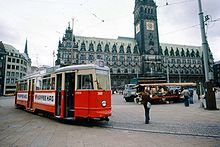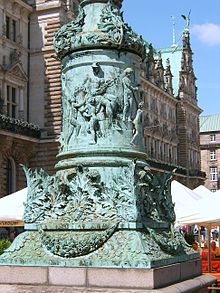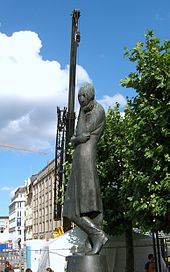Rathausmarkt (Hamburg)
The Rathausmarkt is the central, almost rectangular square in front of the Hamburg City Hall . Located in the Bannmeile , it is a meeting place for major events.
location
The Rathausmarkt in the old town forms the center of Hamburg's inner city . The south-western side is almost entirely occupied by the town hall. Next to it, the old wall, which runs in place of a former fortification, flows onto the square, the other side of which is occupied by the former Reichsbank building with the Bucerius Kunst Forum . North of the Rathhausmarket on Reesendamm and ends less Alster with the underlying Alsterarkaden . The lock bridge with the town hall lock below to the Alsterfleet leads further into the Neustadt to the Alten Post / Poststraße and the crossing Neuer Wall . The north-western side is occupied by office and commercial buildings, interrupted by the merging streets Reesendamm, Plan, Hermannstraße and the shopping street Mönckebergstraße , which run towards the town hall. To the south lies the long front of the Versmannhaus and the streets Rathausmarkt-, Kleine- and Große Johannisstraße, which meet at the Rathausmarkt-Hof and lead into the Große Burstah .
history
The town hall market was laid out after the great fire of 1842 , which also destroyed the old town hall on Trostbrücke and the houses in the area around today's square, with the exception of the new Hamburg stock exchange (1839/41).

Shortly before the town fire , the medieval monastery and church of St. Johannis in the densely built-up area were demolished. The Johanniskirche, which has only been used as a magazine since the French era in Hamburg , was located at the southern end of the square. Your choir space was limited to the east by a gable that ran diagonally to the nave (formerly the street Hinter dem Breite Giebel ). Adjacent to the church to the north, there was the colonnade running around the burial site, as well as other monastery and farm buildings that reached to today's center of the square and Hermannstrasse and Mönckebergstrasse. These were last demolished after the Johanneum moved .
St. Mark's Square in Venice , which also opens onto the water, was the model for the design of the Rathausmarkt . The plan of the ensemble with a flight of stairs and the design of the Kleiner Alster , Alsterarkaden , Schleusenbrücke, Rathaus and other buildings was designed as early as 1842.
Today's town hall with the Hanseatic Stock Exchange behind it was not completed until 1897. The areas to be built on were left free until construction began.
On April 19, 1933, the Rathausmarkt was renamed Adolf-Hitler-Platz (on the same day Hitler was made an honorary citizen of the city of Hamburg). The renaming took place after the end of the war in 1945.
Located in the middle of the city center, the square, which is surrounded on three sides by main streets, was also of great importance as a traffic junction in the Hamburg tram network until the early 1970s . After it was finally closed in October 1978, it was converted in 1982 to calm the traffic - because of the slightly reddish granite slabs used, people are now jokingly talking about the “red square”. Changing leisure events such as the Stuttgart Wine Village , open-air cinema or rock spectacle and a large Christmas market during Advent keep the Rathausmarkt attractive today.
Monument to Kaiser Wilhelm I.
From 1903 a large equestrian statue in memory of Kaiser Wilhelm I stood as part of an extensive monument ensemble in the middle of the Rathausmarkt. In 1930 it was removed from the Rathausmarkt and repositioned several times. Today the remaining parts can be seen on the corner of Holstenwall / Sievekingplatz (in the park next to the civil justice building).
The two flagpoles belonging to the facility remained on the Rathausmarkt in 1930. Today they are closer to the town hall and are used for official flagging .
Rathausmarkt-Hof
The town hall market yard at the corner of Little Johannisstraße is a 1899 by architects Hanssen & Meerwein built office building . Just like the Versmannhaus on Mönckebergstraße , it was architecturally adapted to the town hall and, like this, is a listed building . Irritatingly, the house numbers here already count towards Mönckebergstrasse . In addition to house number 1 for the town hall itself, only the houses on the northeast side with the address Rathausmarkt can be adorned.
Today the Hanseatic Stock Exchange of the Hamburg Stock Exchange , or the Börsen AG BÖAG , which has now merged with Hanover, has its Hamburg headquarters here (Kleine Johannisstrasse 4).
Heinrich Heine Monument
The first Hamburg Heine monument, which Hugo Lederer created in 1911, was ceremoniously unveiled in 1926 in Hamburg's city park . In 1933 it was torn down by the National Socialists , for whom Heine was hated as a Jewish poet and democrat. Later the monument was melted down for metal extraction for the armaments industry.
A new creation by Waldemar Otto has adorned the Rathausmarkt since 1982, stylizing the Lederer monument. Two picture plates ( half-reliefs ) are attached to the base as memorials , the front one depicts the book burning of 1933 , the rear one the history of the fall of the monument.
The Heine memorial was celebrated in 1989 by Hannes Wader . (“Description of the monument” on the album Nach Hamburg ).
traffic

The Rathaus underground station - formerly Rathausmarkt - with platforms on both sides on the ring line (today U3) was opened on February 15, 1912. During the Nazi era between 1934 and 1945 it was called Adolf-Hitler-Platz . When in 1958, as part of the extension of the so-called “KellJung” line (U1), the first underground pedestrian passage made it possible to change to the nearby Jungfernstieg station , both stations were given the name Rathaus . After the completion of the City-S-Bahn line and the “U2” (today the diameter line from Niendorf to Billstedt ), the Jungfernstieg station of the U1 got its old name back in 1973 with the opening of the traffic junction under the Inner Alster . The Rathausmarkt was a tram junction until the 1970s . The last tram of line 2 in the direction of Schnelsen ran on September 30, 1978. Afterwards, the square was the meeting point for the night buses .
See also
- Hamburg Memorial
- Alsterfleet
- Green Wall : song and benefit single action for Africa 1985 with Hans Hartz, Heinz Rudolf Kunze, Udo Lindenberg, Hendrik Schaper and Rolf Zuckowski, recorded live on the Rathausmarkt on January 25, 1985
Individual evidence
- ^ Büttner / Jochmann Hamburg on the way to the Third Reich · Development years 1931–1933 , 3rd edition, Hamburg 1985
- ↑ Memorials in Hamburg: Heinrich Heine Monument. Rathausmarkt (Neustadt)
Events
The Rathausmarkt is regularly used as an area for various events / presentations. These include, among others
- Rock spectacle
- Hamburg open-air cinema
- Hamburg Christmas Market
Web links
Coordinates: 53 ° 33 ′ 3 ″ N , 9 ° 59 ′ 35 ″ E





